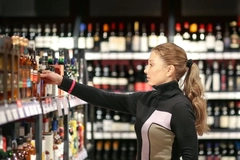SIG QR code research: China embracing connective, Brazil and Europe sitting on potential

09 Sep 2019 --- SIG – a leading systems and solutions provider for aseptic packaging – has conducted almost 3,000 interviews to better understand how consumers interact with QR codes. In Brazil and Europe, usage rates were fairly similar with just 7 percent and 8 percent of consumers, respectively, scanning QR codes several times a week. In China, however, this figure rose to 50 percent – with consumers predominantly hoping to gain financial rewards. This not only shows that QR codes are far more established in China, but also that brands in Brazil and Europe could do more to promote their value to consumers, SIG indicates.
In today’s on-demand and digitalized world, consumers are more connected and informed than ever. They can now access information about businesses and their products in an instant. As digital consumers and connected spenders adopt new behaviors and communication channels, brands are having to work even harder to reach, understand and engage them.
In highly competitive food and beverage markets, connected packaging has emerged as a unique way for producers to connect with consumers. Solutions like scannable QR codes are being utilized more and more on consumer products, turning physical packs into interactive tools.
“In a world where technology can now be integrated into everything, connected packaging is an incredible opportunity for companies to play a bigger role in consumers’ lives,” notes Ayed Katrangi, Senior Product Manager Automation and Digitalization for SIG. “Through interactive functionalities and enhanced user experiences, brands can offer real value to consumers.” Ayed Katrangi, Senior Product Manager Automation and Digitalization for SIG
Ayed Katrangi, Senior Product Manager Automation and Digitalization for SIG
China is leading the way
SIG found that QR code usage is considerably more established in China, with 50 percent of consumers scanning weekly, compared to 7 percent in Brazil and 8 percent in Europe.
“Chinese consumers are heavy users of QR codes, driven by the young generation and their open attitude to try and adopt new technologies, especially in digital fields,” Katrangi tells PackagingInsights. “Furthermore, companies and brands, together with WeChat application, have boosted the usage of QR Codes in China, creating new habits of daily usage and purchase. For example using QR codes for online shopping, cashless payments, communications and rewards.”
Chinese consumers are engaging with QR codes on packaging several ways, according to Katrangi. This includes brand rewards and incentives, re-orders, authenticity confirmation and origin traceability. On the producer side, Chinese companies are using QR codes as a means to ensure the visibility, control and safety of products throughout the supply chain.
“In Brazil and Europe l, QR codes have still an opportunity to grow,” Katrangi adds.
Consumers in Brazil and Europe scored QR codes highly for being innovative, useful and easy to use, as well as important for product peace of mind. But many also cited a lack of awareness as a major hurdle to scanning more often. To reach the high engagement levels seen in China, brands in Brazil and Europe need to provide clearer information on what consumers stand to gain with connected packaging, SIG suggests.
Trust and transparency rule
By using fraud-proof printing technologies, QR codes offer a viable way to increase product trust and transparency. In Brazil and Europe, SIG found consumers are particularly interested in production and expiry dates as they want to learn about a product’s journey and quality. In China, confirmation of product authenticity is key with 94 percent of consumers believing this is essential for product peace of mind.
In all surveyed markets, it’s clear that unique and fraud-proof QR codes have the potential to ensure more product transparency, peace of mind and ultimately engagement, SIG reports. In Brazil (98 percent) and Europe (73 percent), consumers are ready to scan QR codes more for brands offering transparent information, while 78 percent and 39 percent, respectively, would scan QR codes regularly to communicate directly with their brands of choice. In China, 65 percent of consumers think financial gain is the most important reason to scan.
In China, 65 percent of consumers think financial gain is the most important reason to scan.
“Connected packaging enables the collection of real-time data throughout the product journey – from sourcing, processing, filling, quality checks and logistics, right up to the supermarket shelf,” says Katrangi. “All this data can be linked to each individual package, so relevant and transparent information is always available to consumers.”
Scanning for the right reasons
For brands using QR codes on packaging, knowing the right consumer incentives is crucial. In all surveyed markets, instant free gifts – closely followed by cashback – is seen as the most important trigger to scan a QR code. Also, in Brazil and Europe, a high percentage of consumers are in agreement that promotions make a brand more attractive when shopping and are ready to scan QR codes more frequently to receive rewards.
In China, scanning QR codes for financial gain is already a well-established practice. In fact, 65 percent of consumers here think it’s the most important reason to scan – placing financial rewards far above peace of mind, shopping assistance, information or entertainment. As China shows, gifts are key to the heart of consumers, meaning brands that offer QR gifts, cash-back offers and shopping coupons via QR codes will stand out.
Entertainment equals engagement
With QR codes, consumers can access a wealth of interactive content with their smartphones, such as videos, songs, games and quizzes, all of which can make a brand and its products seem more attractive. In Brazil and Europe, video content, including TV shows, movies and animations, is seen as the most appealing entertainment form for 56 percent and 40 percent of consumers respectively.
In China, however, consumers are more interested in accessing online gaming with 59 percent of consumers rating this as their preferred entertainment. In addition, 59 percent of consumers also want to broadcast their product interactions on social media, highlighting how consumers are looking to share and discuss brand experiences. What’s clear for all markets is that on-pack entertainment is a proven gateway for consumer engagement.
Enhanced shopping experiences
In addition to entertainment, QR codes can also facilitate more convenient shopping experiences. This includes everything from knowing where to repurchase products and getting the latest in-store promotions to having direct contact with customer service and being able to re-order products quickly online.  The ability to re-order products quickly online is a major benefit of QR codes.
The ability to re-order products quickly online is a major benefit of QR codes.
In Brazil (72 percent) and Europe (41 percent), consumers want to know the physical locations where they can purchase the relevant product. Brazilian consumers (75 percent) are ready to scan QR codes regularly to access online shopping assistance. In China, consumers are also interested in knowing where to buy a product, but the majority (80 percent) want to be taken directly to the product company’s website to shop via quick links.
In all markets, it’s apparent that consumers are ready to switch to brands that offer more convenient online shopping assistance and options. QR codes provide an ideal platform for these enhanced experiences, which can help increase product sales and brand loyalty.
Connecting to consumers
As SIG’s findings show, QR codes can facilitate more engagement and loyalty through product authenticity, information and entertainment. They can also guide consumers through the purchasing process, which ultimately leads to more sales.
For many consumers, particularly in China, scanning a QR code has now become second nature and an integral part of the shopping and product experience. But with usage increasing around the world, now is the time for brands to tap into this potential and gain a competitive edge, SIG says.
To help brands and producers unlock the potential of connected packaging, SIG offers a range of market-ready solutions as part of its Connected Pack platform. These solutions combine unique digital coding technologies and track-and-trace capabilities to ensure connectivity and transparency in every pack and drive greater digital interaction and engagement.
“SIG’s Connected Pack platform offers a whole range of traceability and interactive packaging solutions,” Katrangi explains. “These allow consumers to easily access product quality information, play games, watch videos, read recipes, participate in prize draws and even receive personalized communication – all through the pack itself.”
By Joshua Poole












